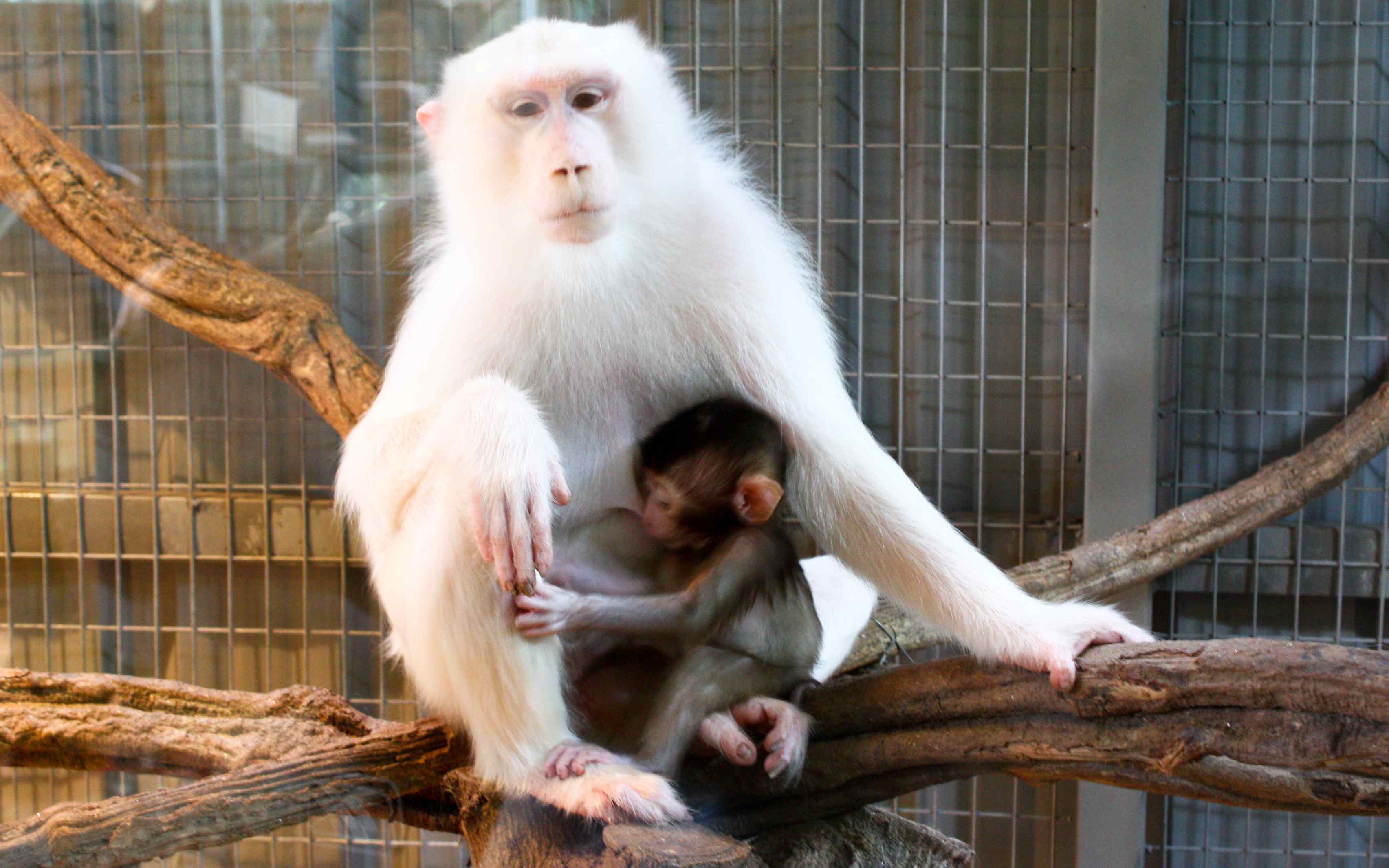
Albino monkeys, with their unique white fur and striking red or pink eyes, have captured the fascination of animal enthusiasts around the world. These extraordinary primates possess a genetic condition called albinism, which affects the production of melanin, the pigment responsible for skin, hair, and eye color. In this article, we will explore 18 fascinating facts about albino monkeys, shedding light on their characteristics, habitats, behavior, and conservation efforts. From their vulnerability in the wild to their captivating appearance, these animals have a story that is both intriguing and important. So, let’s delve into the enchanting world of albino monkeys and discover the wonders they bring to our planet.
Key Takeaways:
- Albino monkeys have a rare genetic condition called albinism, which affects their skin, hair, and eyes. Their unique appearance makes them vulnerable to sunburn and vision problems, but also captivates people with their charm and serves as a symbol of nature’s diversity.
- These rare albino monkeys are easily recognizable by their white fur and red or pink eyes. They face social challenges within their troop and are at higher risk of predation due to their conspicuous appearance. Their genetics provide valuable opportunities for scientific research and they can serve as ambassadors for wildlife conservation efforts.
Albino monkeys have a rare genetic condition.
Albino monkeys are born with a genetic condition called albinism, which causes a lack of pigmentation in their skin, hair, and eyes. This condition is extremely rare and can affect monkeys of different species.
Their white fur makes them easily recognizable.
One of the most noticeable characteristics of albino monkeys is their white fur. This lack of pigmentation makes them stand out in their natural habitats, making them easily recognizable among their fellow monkeys.
Albino monkeys have red or pink eyes.
Due to the absence of pigmentation in their eyes, albino monkeys often have red or pink eyes. This is caused by the reflection of blood vessels and the lack of melanin in their eye tissues.
Their lack of pigmentation makes them more vulnerable to sunburn.
Without the protective melanin in their skin, albino monkeys are more susceptible to sunburn. They must seek shade and take extra precautions to avoid prolonged exposure to sunlight to protect their sensitive skin.
Albino monkeys are more prone to vision problems.
The absence of pigment in their eyes can lead to various vision problems for albino monkeys. They may experience issues such as photophobia, poor depth perception, and increased sensitivity to light.
They may face social challenges within their troop.
Albino monkeys may experience social challenges within their troop due to their distinctive appearance. They may face exclusion or teasing from their fellow monkeys, which can impact their social interactions and hierarchy.
Albino monkeys have unique behavioral adaptations.
Albino monkeys have been observed to exhibit certain behavioral adaptations to compensate for their albinism. For instance, they may be more vigilant and rely on other senses, such as hearing and touch, to navigate their surroundings.
Albino monkeys can be found in various monkey species.
Albinism can occur in different monkey species, ranging from capuchins and squirrel monkeys to macaques and baboons. Each species may exhibit slight variations in their albino characteristics.
They are a rare sight in the wild.
Albino monkeys are incredibly rare to come across in the wild. Their unusual appearance and potential survival challenges make their population scarce compared to their non-albino counterparts.
Albino monkeys may face higher predation risk.
Due to their conspicuous white fur and potential visual impairments, albino monkeys may face heightened predation risk in their natural habitats. Their lack of camouflage can make them an easier target for predators.
They require special care in captivity.
Albino monkeys kept in captivity need special care and attention to ensure their well-being. This includes providing them with appropriate shelter, diet, and addressing their specific health needs.
Albino monkeys have a unique charm.
Despite their differences, albino monkeys possess a unique charm that captivates many people. Their striking appearance and rarity make them subjects of interest and fascination.
Their genetics can be studied for scientific research.
Albino monkeys provide valuable opportunities for scientists to study the genetics underlying albinism. Research conducted on albino monkeys can contribute to a deeper understanding of genetic conditions and potential treatments.
Albino monkeys can have health issues related to their condition.
Albinism in monkeys can be associated with certain health issues. These may include skin sensitivities, increased susceptibility to infections, and higher risk of developing vision-related disorders.
They can be found in protected wildlife reserves.
Some protected wildlife reserves may have albino monkeys under their care. These reserves provide a safe environment for them to thrive and protect them from potential threats in the wild.
Albino monkeys can be ambassadors for wildlife conservation.
Albino monkeys, with their unique appearance and vulnerability, can serve as ambassadors for wildlife conservation efforts. Their presence can help raise awareness about the importance of protecting endangered species and their habitats.
Their survival in the wild depends on various factors.
The survival of albino monkeys in the wild depends on several factors, including access to food sources, protection from predators, and successful social integration into their troop.
Albino monkeys are a symbol of nature’s diversity.
Albino monkeys remind us of the incredible diversity found in nature. Their existence highlights the uniqueness and adaptability of different species, showcasing the wonders of the animal kingdom.
Conclusion
Albino monkeys are fascinating creatures that capture the imagination with their unique appearance. As we have explored in this article, albino monkeys possess several distinct characteristics, making them stand out among their peers in the animal kingdom.
The albino mutation affects the production of melanin, resulting in their distinct lack of pigmentation. This lack of pigment gives them their characteristic white or pale appearance, along with pink or red eyes.
Despite their striking appearance, albino monkeys face several challenges in the wild, including increased vulnerability to predators and significant sun sensitivity due to their lack of protective melanin. However, these resilient creatures have adaptations and behaviors that help them thrive in their natural habitats.
Studying and understanding albino monkeys not only increases our knowledge of their unique biology but also provides valuable insights into the broader field of genetics and the impact that mutations can have on species survival. Protecting their habitats and ensuring their conservation is crucial for the continuation of these remarkable creatures.
FAQs
Q: What is an albino monkey?
A: An albino monkey is a monkey that is born with a genetic mutation affecting its production of pigment, resulting in a lack of coloration in its skin, fur, and eyes.
Q: Are albino monkeys rare?
A: Yes, albino monkeys are considered to be rare. The albino mutation is a relatively uncommon occurrence in the animal kingdom, including among monkey species.
Q: Are albino monkeys more susceptible to health issues?
A: Yes, albino monkeys may experience higher sensitivity to sunlight, increased vulnerability to predators, and potential vision impairments. Their lack of protective melanin makes them more prone to these challenges.
Q: Can albino monkeys survive in the wild?
A: While albino monkeys face additional challenges compared to their pigmented counterparts, they can survive in the wild with adaptations and behaviors that help them cope with their unique circumstances.
Q: How can we protect albino monkeys?
A: Protecting albino monkeys involves safeguarding their natural habitats, implementing conservation measures, and raising awareness about the importance of preserving biodiversity.
Was this page helpful?
Our commitment to delivering trustworthy and engaging content is at the heart of what we do. Each fact on our site is contributed by real users like you, bringing a wealth of diverse insights and information. To ensure the highest standards of accuracy and reliability, our dedicated editors meticulously review each submission. This process guarantees that the facts we share are not only fascinating but also credible. Trust in our commitment to quality and authenticity as you explore and learn with us.


